COVIDFREE App: The User-Enabling Contact Prevention Application: A Review
Volume 7, Issue 2, Page No 149-155, 2022
Author’s Name: Edgard Musafiri Mimo 1,a), Troy McDaniel1, Jeremie Biringanine Ruvunangiza2
View Affiliations
1 Arizona State University, Systems Engineering, The Polytechnic School, Mesa, 85212, USA
3 University of Mons, Computer Science, The Polytechnic School, Mons, 7000, Belgium
a)whom correspondence should be addressed. E-mail: emusafir@asu.edu
Adv. Sci. Technol. Eng. Syst. J. 7(2), 149-155 (2022); ![]() DOI: 10.25046/aj070215
DOI: 10.25046/aj070215
Keywords: COVIDFREE App, Location-based services, Social distancing, Covid-19, Location tracking
Export Citations
The use of Covid-19 contact tracing applications has become almost irrelevant now that several flavors of Covid-19 vaccine have been developed and are constantly being distributed to people during the pandemic to help alleviate the need for lockdowns. Also, the availability of at-home testing kits and testing sites means that people do not need to contact trace as much since individuals can get tested and follow the health guidelines in ensuring their health and the safety of others around them. Nevertheless, governments around the world are still faced with the Covid-19 pandemic challenge because the virus is not yet controlled due to the different variants and the rapid contamination rate that outpaced the logistic supply chain processes in the distribution of the vaccines and the time it takes in convincing individuals to take the vaccine swiftly to reach herd immunity. Therefore, the current pressing need is that of addressing the infection rate by finding ways and solutions to minimize or slow down contamination among people especially with the increased number of variants. This paper is an extension of the “COVIDFREE App: The User-Enabling Contact Prevention Application” work originally presented in 2020 IEEE International Symposium on Technology and Society (ISTAS) conference that provided a smartphone application architecture with the goal of proactively enabling users to avoid encountering infected Covid-19 patients. This paper elucidates and discusses additional concerns not thoroughly addressed previously regarding the Covid-19 variants, vaccines, booster, and infection rates, and demonstrates the feasibility of the proposed architecture with a web application prototype. This paper also discusses the benefits of funding and developing contact tracing and prevention applications, such as the COVIDFREE App, to provide the needed ingredient in reducing the infection rate and provide citizens the needed preparedness and relief in actively fighting the virus.
Received: 11 February 2022, Accepted: 16 March 2022, Published Online: 19 April 2022
1. Introduction
The world has made so many financial, social, political, and technological efforts and investments in fighting and controlling the Covid-19 virus spread as a remedy to end the virus fueled pandemic the world was forced in. All the efforts were made as more information about the virus became available starting with how one can avoid catching the virus to what one must do once infected to recover and not spread the virus to others and so on and so forth. The declared Covid-19 International Public Health Emergency Issue that began in 2020 has drastically changed the world, and there is no going back to normal anymore rather there is a contemplation of adopting a new normal. Covid-19 is a highly contagious respiratory virus with several unique features that have been identified with the ever-increasing number of infection cases to date.
With more detail about Covid-19 available today on how some infected individuals do not develop symptoms right away, while others stay asymptomatic throughout the duration of their treatment, and others are able to catch the different mutation and variation of the virus, it is important to evaluate all the alternative remediation solutions that can be instigated to manage the pandemic health crisis more efficiently. Several governments around the world have responded by exploring and seeking to harness technology in the fight against this fatal illness. Covid-19 has influenced the lives of almost everyone on the earth by forcing governments around the world to implement lockdowns and sanctions, and in certain situations, enforce measures that involve work-from-home regulations, implement strong physical distancing safeguards, and set up emergency health responses that necessitate thorough rearrangement to perform mass testing, patient managing, and care giving [1].
These efforts are aimed at containing and controlling the virus’s transmission until definitive cures or vaccines are produced and widely administered. Considering the effort and investment in producing the vaccines and the vaccine boosters, and getting people vaccinated and boosted, there is still a lot of work to be done in combating the virus and ensuring people’s safety [2]. As a result, it is evident that the Covid-19 testing and vaccine solutions are maybe the remedy for the virus, but not the remedy of its infection rate. They simply cannot keep up with the pace of transmissibility of the virus as the supply chain logistic processes are also impacted by the pandemic. Hence, there is a need to address the contamination issues among the people by ensuring the prevention of contacts or encounters among people proactively because potential Covid-19 variants may continue to develop due to the constant virus reproduction among humans [3].
This is the intention of the COVIDFREE app because governments all over the world are inclined to adopt and employ mobile contact tracing and awareness applications to automatically manage, trace, and investigate recent interactions of both the newly tested Covid-19 infected individuals and those that are recovering from it regardless of vaccine status [4]. The potential use of such mobile and web applications has produced numerous discussions surrounding privacy, security, data management, contact projection algorithms, and cyber-attack vulnerabilities. The previously proposed smartphone application architecture that COVIDFREE employs aims to minimize the above-mentioned concerns by using only minimal information about the users and provide abstraction layers to ensure the security and the privacy of users are preserved in the process of giving the users more control and privacy of their data [1].
The COVIDFREE application aims to enhance users’ situational mindfulness through communication of unsafe locations and proactively prompt them to avoid these locations while dynamically taking into the account the daily reported infection rate per location. Additionally, the COVIDFREE application provides the means of customizing by allowing users the control of considering their Overall Risk Density Safety Factor in the risk calculation based on health requirements and numerous customizable user-specific situations [1]. This paper discusses a prototype of a previously proposed proactive smartphone app with a centralized approach that aids uninfected people regardless of their vaccination status to overcome the stress and fear of getting contaminated by improving their situational awareness. The proposed proactive smartphone application enables users to informatively avoid congested places and tested infected individuals because the application notifies them whenever they are within 10 to 50 feet (depending on parameters) of an anonymous, confirmed infected person [1].
2. Insights and Concerns
2.1. General Anxieties
There are several unsolved questions about how technology can help provide a remedy in addressing the Covid-19 transmissibility issues even now that the vaccines and vaccine boosters are available, since they are not yet distributed everywhere due to their demands and the citizens’ decision in taking them. The questions surrounding the quarantine period and the habits and behaviors of citizens in how they choose to live their lives, whether it is by masking up or just limiting their movements outside of their safe locations, cannot be overlooked. The simple fact that many Covid-19 patients are asymptomatic leaves the world with so little options to consider in providing the remediation needed to enable the minimization of the transmission of the virus from one patient to others [1][5].
If some patients do not have symptoms right away and some are symptoms free while carrying the virus, then the Covid-19 infection rate would remain a burden to carry as more undercover carriers could prove difficult to identify and avoid [5]. As a result, Covid-19 testing for asymptomatic individual is problematic since infected asymptomatic individual may have already spread the virus to numerous others before being tested. Consequently, it is critical to guarantee that individuals feel secure going to and returning from testing centers by understanding how infectious their surrounding is. For instance, regardless of symptoms, it is beneficial for users to know how close they may be to someone who is contaminated and has had their infection confirmed by a previously taken Covid-19 test.
2.2. Tracking Complexity
The complexity of Covid-19 spread is vast, so there is a need of a proactive response strategy that locates confirmed infected people outside their safe location and provides means of avoiding them anonymously without any form of profiling through direct notification of users’ surrounding exposure range [1][6]. This proactive strategy is urgently needed to ensure people feel safer and more educated about their environments when it comes to Covid-19 health risks. We believe that proactively notifying people to avoid encountering a person that has tested positive for Covid-19 will help minimize the infection rate and allow the vaccines and boosters’ effects to be effectively noticed as herd immunity is being achieved.
Reactive techniques of contact tracing or a passive approach of waiting on the vaccines and boosters only, would not provide the rapid remedy that people are waiting for as long as the contamination rate stays high and unaddressed in a proactive manner that of relying on informative individual discretional social distancing and isolation. The only possibilities left imminent involve the tradeoff between what privileges one can live with and what necessities one cannot live without as new Covid-19 demands need to be satisfied and new habits developed to cope with the world’s present changes of the new normal. Hence, it is necessary to provide tools that give users insights and proactive prompt notifications to avoid the symptoms free carriers and minimize the potential risk of catching the virus. This is a great way to make use of the collected testing daily data to ensure the location of the individuals that test positive are activated until they test negative depending on their vaccination status and their quarantine periods. It will ensure other users would promptly avoid them should interactions’ occasions arise.
Therefore, the method of preventing anyone from getting the virus from the afflicted person regardless of their vaccine status that the COVIDFREE application provides, ensures people are informed and at peace with their movements while minimizing their concerns regarding the virus and their health and safety. With a couple of years in the pandemic, there are still some concerns regarding Covid-19 transmission and propagation that are yet to be completely understood regarding the variety of ways the virus can spread [6]. Thus, it is critical to access the user’s physical surroundings, social connections, and health to determine the likelihood of being contaminated. The virus’s complicated transmission characteristic generates a lot of concerns among the people. As a result, recommendations to maintain social distance and wear personal protective equipment (PPE) help to limit the virus’s transmission. The case that someone can get the virus on their way to the testing site and then obtain a negative test report to become an undercover carrier in the testing process. Being uninformed about one’s immediate surrounding adds to the concerns and does not help answer the question of when the virus is spread especially with the case of vaccinated individuals’ potential to be contaminated again.
Another issue that makes the concerns worse is the amount of time the virus takes to disperse in the air, which varies based on area and spaces’ ventilation systems. Thus, without the full visibility of the virus’ transmitters, it’s hard to identify, track, and locate unsafe sites accurately without depending on the tracking of individuals who have tested positive. This is a way that can help provide insights to address the question of where someone can potentially get Covid-19 by being in the vicinity of an active carrier (person to person) rather than a passive one (via the environment). It is convoluted to make the right informed decision regarding the virus’s transmissibility during travel if critical information and notifications are not available to people in real time to support informed travel experiences.
3. Simplified Prototype Architecture
The overall density safety factor proposed earlier must be adjusted accordingly when considering the vaccine safety factor to determine how to account for the efficacy of the vaccine and their booster to provide a realistic vaccination safety factor [1]. The proposal may be using the normalized reported average efficacy value per age group from a credible vaccine approval institution like the Food and Drug Administration (FDA) agency. Nevertheless, the previously proposed normalized overall density safety factor along with all the considered factors as discussed in this paper remain a great indicator and tool to dynamically adjust per users’ needs the notification distance range to facilitate users in avoiding encountering a Covid-19 carrier. The overall density safety factor can also be coupled with other factors like reported infection rates to provide an enhanced user’s situational representation.
The previously proposed architecture required the necessity of the health center experts in providing the positive test data to the database and registering the Covid-19 carrier for tracking. To test the prototype, the requirement of the health center experts was circumvented, and the database was loaded with fictitious Covid-19 carriers with actual locations against which the actual devices were tried to ensure they are proactively notified to avoid coming in contact. The current prototype implementation provides a more privacy enhanced solution by circumventing the necessity of the health center interference of user’s medical status as it pertains to Covid-19 and their personal risks. Thus, it increases users’ privacy by eliminating the direct linkage of users’ medical records and their current Covid-19 test results and vaccine status as well as facilitate the usability of the application’s rapid prototype. Figure 1 below shows an adapted architecture of the previously proposed centralized architecture that is used for the prototype.
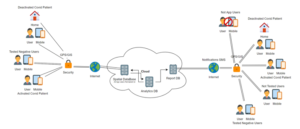
Figure 1: A diagram of the adapted architecture of the COVIDFREE centralized architecture prototype created using flat-color-icons.xml from the app.diagrams.net website.
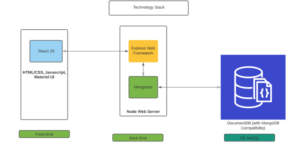
Figure 2: An illustration of the technology stack enabling the COVIDFREE application prototype created using flat-color-icons.xml from the app.diagrams.net website.
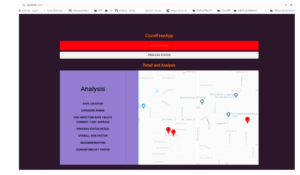
Figure 3: A screenshot showing the prototype of the COVIDFREE application’s user interface
4. Used Technologies
To ensure the feasibility of the application in providing a prototype demo that other developers can use, many web application frameworks were considered for this project like Django, Ruby on Rails, MEAN and MERN frameworks. We decided to go with the MERN stack. MERN stands for MongoDB, Express, React, and Node, after the four key technologies that make up the stack. The technology stack enabling the prototype functionalities is shown in Figure 2 above.
The reason for choosing the MERN stack is that it provides an opportunity for rapid prototypes and proof of concepts. JavaScript is the primary programming language that is used in this project, and it offers the benefit of using one language for both the prototype’s front-end and back-end. We used MongoDB to save the collected data. MongoDB is a document database model that maps to how developers think and code, and it provides a powerful, unified query API. MongoDB powers faster and more flexible applications. Node and Express are used for the back-end implementation. Node is an asynchronous event-driven JavaScript runtime. It is designed to build scalable network applications.
5. App User Interface
Considering the front-end or the user interface UI, we used React. React is a free and open-source front-end JavaScript library for building user interfaces based on UI components.
We collect the data through the UI. Most data are collected dynamically without users’ interaction. One of the most important data points that is collected is the user’s location, which is associated with the user’s registered phone number. We use the user’s location to determine the safety of his position relative to nearby potential Covid-19 carriers while considering the infection rate in the user-specific location to determine the proper notification distance range.
The application’s algorithm 1 shown below computes the best-case scenario for the end-user to avoid getting contaminated in the first place.
5.1. Algorithm
| Algorithm 1: User’s Covid-19 Prevention Situational Response | |||||
| Result: Action Recommendation with Warnings | |||||
| Get User Safe Location;
Get User Current Position; Get Users’ Geolocation in Same Zip Code; |
|||||
| while User Not in Safe Location do | |||||
| Get Closest Covid-19 Carrier Position;
Calculate Social Distance; |
|||||
| if Social Distance greater than 100 Feet then
| GREEN Notification; |
|||||
| else if Social Distance greater than 50 Feet then
| ORANGE Notification; |
|||||
| else if Social Distance less than 50 Feet then | |||||
| RED Notification; | |||||
| else | |||||
| Break; | |||||
| end | |||||
| end | |||||
The application’s algorithm as implemented in the code is designed with the virus prevention approach in mind. The source code is accessible on GitHub at link[1]. The prototype UI is shown Figure 3.
6. App Demo and Use Cases
The prototype explores four different scenarios as use cases to ensure proactive notification to users to enable enough time for users to take appropriate actions based on their specific scenarios.
6.1. User in Safe Location
The first scenario involves the user being in their safe location or within 25 feet of the safe location. When this is the case, the user is deactivated and is no longer tracked. The user is considered safe and providing no apparent threats to anyone regardless of their Covid-19 status since the safe location is also considered the quarantine location where the user is in isolation from the outside world. The user interface of this scenario shows the information and the notification that the users get in real time by having access to the app.
The notification button is triggered to a grey color notification, and only the user’s home or safe location is shown on the map as the user is not in motion. The user can access all the analysis detail on what the process status means regarding all the notifications in detail by using the appropriate provided buttons on the application’s analysis screen. The COVIDFREE application in this case recommends the user to avoid unnecessary trips to ensure they remain safe. The screenshot in Figure 4 below shows a representation of what the COVIDFREE application looks like with test demo data for this use case.
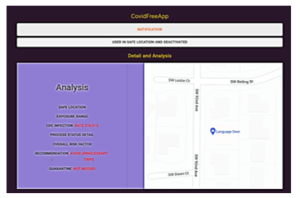
Figure 4: A screenshot showing the COVIDFREE application UI for a user in their safe location.
6.2. User out of Safe Location
The second scenario involves the user leaving their safe location and entering a state of motion moving from one location to another. When this is the case, the user is activated on the map and their position is tracked relative to his safe location and other potential Covid-19 threats agents or carriers. The user’s test condition is considered when they are in motion relative to the potential Covid-19 carriers as the user runs a risk of interacting with a potential carrier. If the user is also a Covid-19 carrier then anonymously their location is also being flagged to be avoided by other users of the application providing a safe environment for all the application’s users. The COVIDFREE application’s user interface of this scenario shows the information and the notification that the users get in real time by having access to the app. The notification button is triggered to a green color notification if the user has not been in a vicinity of a Covid-19 carrier.
In this view, the user’s current location and his safe location can be seen on the map interface of the application indicating the user is in motion and out of their safe location, and thus the user is active. The user can access all the analysis detail on what the process status means regarding all the notifications in detail by using the appropriate provided buttons on the application’s analysis screen. The COVIDFREE application in this case recommends and reminds the user to social distance to ensure they remain safe throughout their trips. The screenshot in Figure 5 below shows a representation of what the COVIDFREE application looks like with test demo data for this use case.
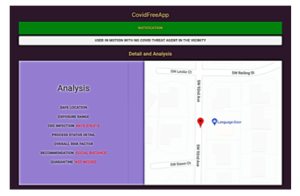
Figure 5: A screenshot showing the COVIDFREE application UI for a user outside their safe location and in motion, approaching no potential Covid-19 threat agents within their 100 ft radius.
6.3. User in motion with Covid-19 threat agents far away
The third scenario involves the user in a state of motion moving from one location to another and coming in the vicinity of an active Covid-19 carrier who is at a relatively far away distance of more than 50 feet from the user. When this is the case, the user remains activated on the map and their position is tracked relative to their safe location and the position of the potential Covid-19 threat agents or carriers. The user’s Covid-19 test condition status is considered when they are in motion relative to the potential Covid-19 carriers as the user runs a risk of interacting with a potential Covid-19 carrier.
If the user is also a Covid-19 carrier then anonymously their location is also being flagged to be avoided by other users of the application providing a safe environment for all the application’s users. The COVIDFREE application’s user interface of this scenario shows the information and the notification that the users get in real time by having access to the app. The notification button is triggered to a yellow color notification since the user is in the vicinity of a Covid-19 carrier that is within their 100 feet radius but more than 50 feet away from them.
In this view, the user’s current location and the Covid-19 carrier locations are shown on the map for the demonstration’s sake and his safe location can also be seen on the map interface of the application when zoomed out indicating both that the user is in motion and out of their safe location as well as in the vicinity of Covid-19 threat carriers. The user can access all the analysis detail on what the process status means regarding all the notifications in detail by using the appropriate provided buttons on the application’s analysis screen. The COVIDFREE application in this case recommends and reminds the user to consider quarantining when they return to their safe location. The screenshot in Figure 6 below shows a representation of what the COVIDFREE application looks like with test demo data for this use case.
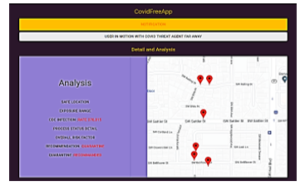
Figure 6: A screenshot showing the COVIDFREE application UI for a user outside their safe location and in motion, approaching potential Covid-19 threat agents that are relatively far away (more than 50 ft apart).
6.4. User in motion with Covid-19 threat agents nearby
The fourth scenario involves the user in a state of motion moving from one location to another coming in the vicinity of an active Covid-19 carrier who is relatively close by the user. When this is the case, the user remains activated on the map and their position is tracked relative to their safe location and potential Covid-19 threat agents or carriers. The user’s test condition is considered when they are in motion relative to the potential Covid-19 carriers as the user runs a risk of interacting with a potential carrier. If the user is also a Covid-19 carrier then anonymously their location is also being flagged to be avoided by other users of the application providing a safe environment for all the application’s users. The COVIDFREE application’s user interface of this scenario shows the information and the notification that the users get in real time by having access to the app.
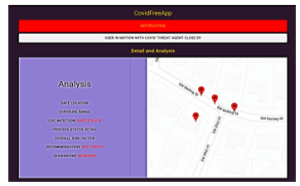
Figure 7: A screenshot showing the COVIDFREE application UI for a user outside their safe location and in motion, approaching potential Covid-19 threat agents that are relatively nearby (Less than 50 ft apart).
The notification button is triggered to a red color notification since the user is in the vicinity of a Covid-19 carrier that is relatively nearby. In this view, the user’s current location and the Covid-19 carrier’s location is shown on the map for demonstration’s sake and their safe location can also be seen on the map user interface of the application when zoomed out indicating both that the user is in motion and out of their safe location as well as in the vicinity of a Covid-19 threat carrier. The user can access all the analysis detail on what the process status means regarding all the notifications in detail by using the appropriate provided buttons on the application’s analysis screen. The COVIDFREE application in this case recommends and reminds the user to consider getting tested and quarantining when they return to their safe location. The screenshot in Figure 7 below shows a representation of what the COVIDFREE application looks like with test demo data for this use case.
7. Conclusion
The current prototype presented in this paper demonstrates that the proof of concept for proactive notifications is feasible and can be further enhanced to provide efficient ways to process the users’ data and provide swift notification to users while collecting the minimum amount of data from the users and providing multiple layers of abstraction to ensure security and privacy of the individuals and data quickly and optimally. To counteract the propagation of Covid-19 and increase citizens’ safety and peace of mind, this article demonstrates the feasibility of COVIDFREE APP by creating a working prototype as a complementary and proactive technological solution that can minimize the likelihood of citizens contracting the Covid-19 virus.
The prototype application employs the previously proposed centralized architecture design to assist users in making educated decisions about how to comfortably and safely navigate from one location to another as well as when they can safely leave areas of isolation (such as their homes) and their immediate social groups. The prototype achieved the goal of improving users’ situational alertness of high-risk sites around them. With better situational mindfulness, it is expected that users will likely feel more convinced and secure about their conduct, flexibility, and travel plans.
We hope this work stimulates parallel efforts to guarantee citizens leverage the available technologies to advance the citizen’s safety and security, and eventually, to save citizens’ lives. There are some opportunities for further developments. Our model gives a unique framework that is easy to use and configure for different machine learning models. For instance, one can implement a federated learning [7] model to optimize an independent user situational model and further enhance the user safety. As the application offers a real-time user notification to prevent contracting the virus and ensures safety, it also ensures the integrity of the information, and the trustworthiness of the data can be accessed using the zero-knowledge proof technique [8] even though the zero-knowledge proof technique is complex and in its early research stage. Nevertheless, it would provide a great way to gain public trust due to its security and privacy awareness implications.
Conflict of Interest
The authors declare no conflict of interest.
Acknowledgment
The authors thank Arizona State University and the National Science Foundation for their funding support under Grant No. 1828010.
- E.M. Mimo, T. McDaniel, “COVIDFREE App: The User-Enabling Contact Prevention Application,” in 2020 IEEE International Symposium on Technology and Society (ISTAS), IEEE: 452–456, 2020, doi:10.1109/ISTAS50296.2020.9462186.
- S. Shiehzadegan, N. Alaghemand, M. Fox, V. Venketaraman, “Analysis of the Delta Variant B.1.617.2 COVID-19,” Clinics and Practice, 11(4), 778–784, 2021, doi:10.3390/clinpract11040093.
- J.A. Plante, B.M. Mitchell, K.S. Plante, K. Debbink, S.C. Weaver, V.D. Menachery, “The variant gambit: COVID-19’s next move,” Cell Host & Microbe, 29(4), 508–515, 2021, doi:10.1016/j.chom.2021.02.020.
- N. Ahmed, R.A. Michelin, W. Xue, S. Ruj, R. Malaney, S.S. Kanhere, A. Seneviratne, W. Hu, H. Janicke, S.K. Jha, “A Survey of COVID-19 Contact Tracing Apps,” IEEE Access, 8, 134577–134601, 2020, doi:10.1109/ACCESS.2020.3010226.
- K. Michael, R. Abbas, R.A. Calvo, G. Roussos, E. Scornavacca, S.F. Wamba, “Manufacturing Consent: The Modern Pandemic of Technosolutionism,” IEEE Transactions on Technology and Society, 1(2), 68–72, 2020, doi:10.1109/TTS.2020.2994381.
- Y.-C. Wu, C.-S. Chen, Y.-J. Chan, “The outbreak of COVID-19: An overview,” Journal of the Chinese Medical Association, 83(3), 217–220, 2020, doi:10.1097/JCMA.0000000000000270.
- H.B. McMahan, E. Moore, D. Ramage, S. Hampson, B.A. y Arcas, “Communication-Efficient Learning of Deep Networks from Decentralized Data,” 2016.
- S. Grzonkowski, W. Zaremba, M. Zaremba, B. McDaniel, “Extending web applications with a lightweight zero knowledge proof authentication,” in Proceedings of the 5th international conference on Soft computing as transdisciplinary science and technology – CSTST ’08, ACM Press, New York, New York, USA: 65, 2008, doi:10.1145/1456223.1456241.
Citations by Dimensions
Citations by PlumX
Google Scholar
Crossref Citations
No. of Downloads Per Month
No. of Downloads Per Country
